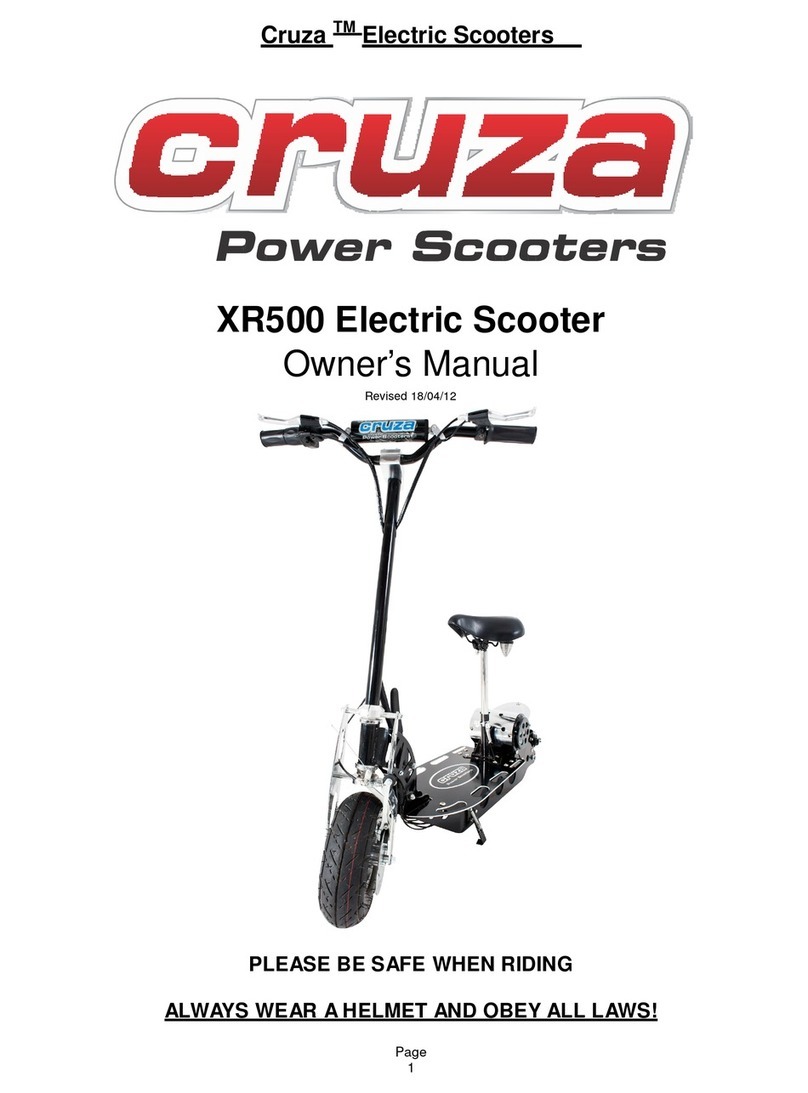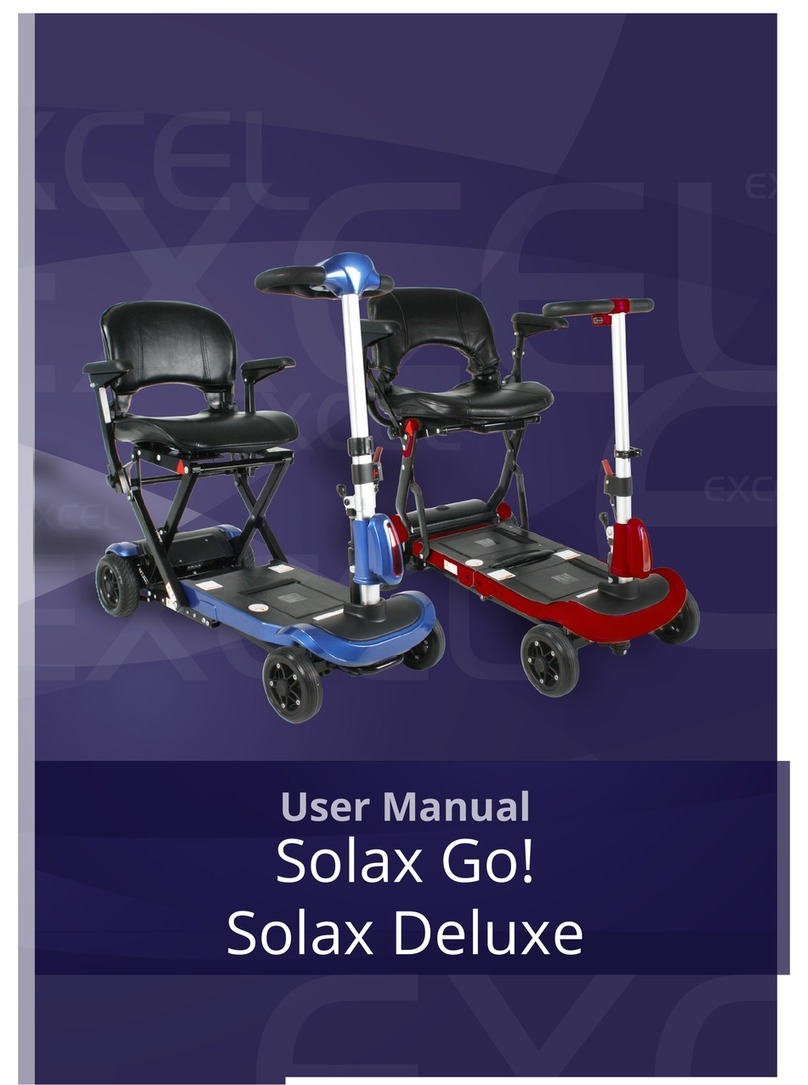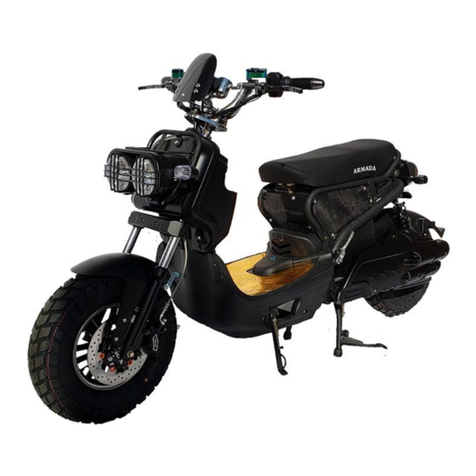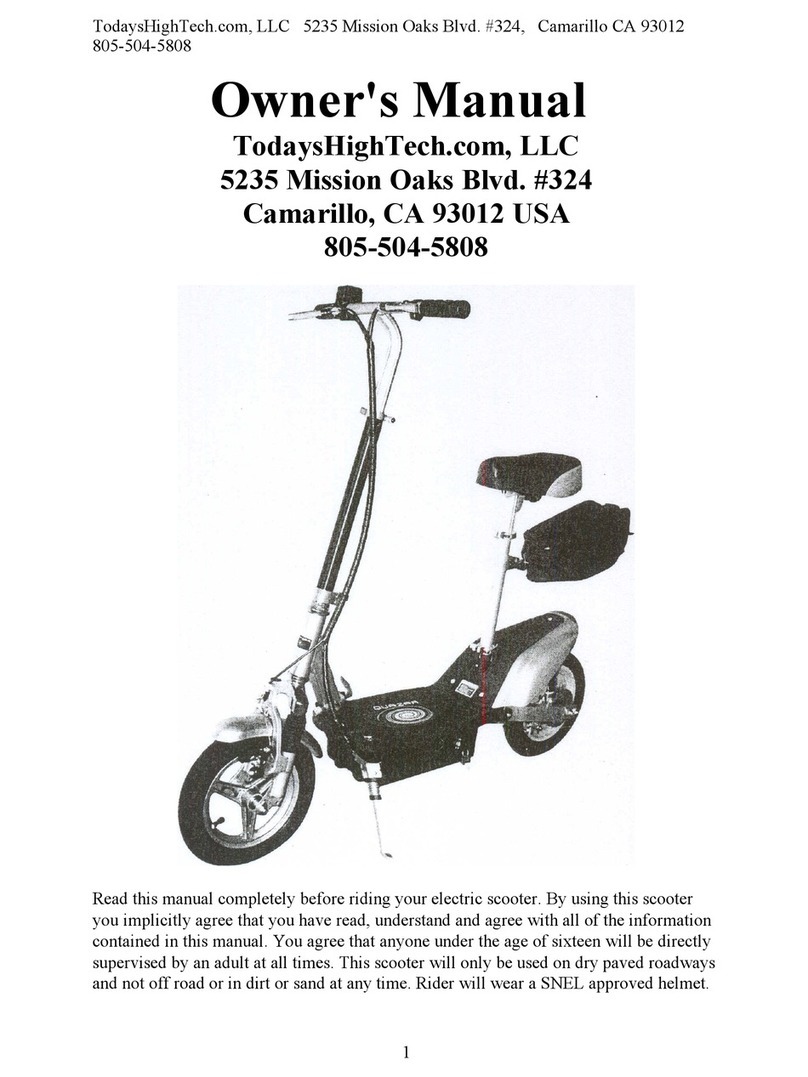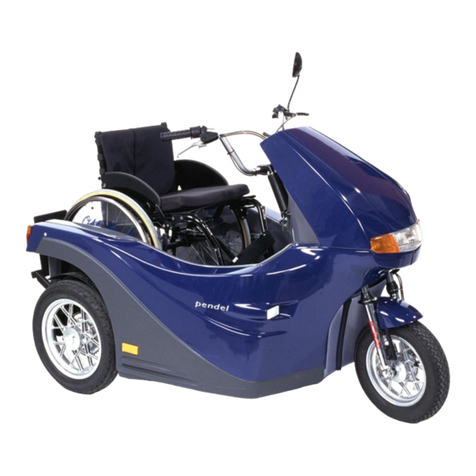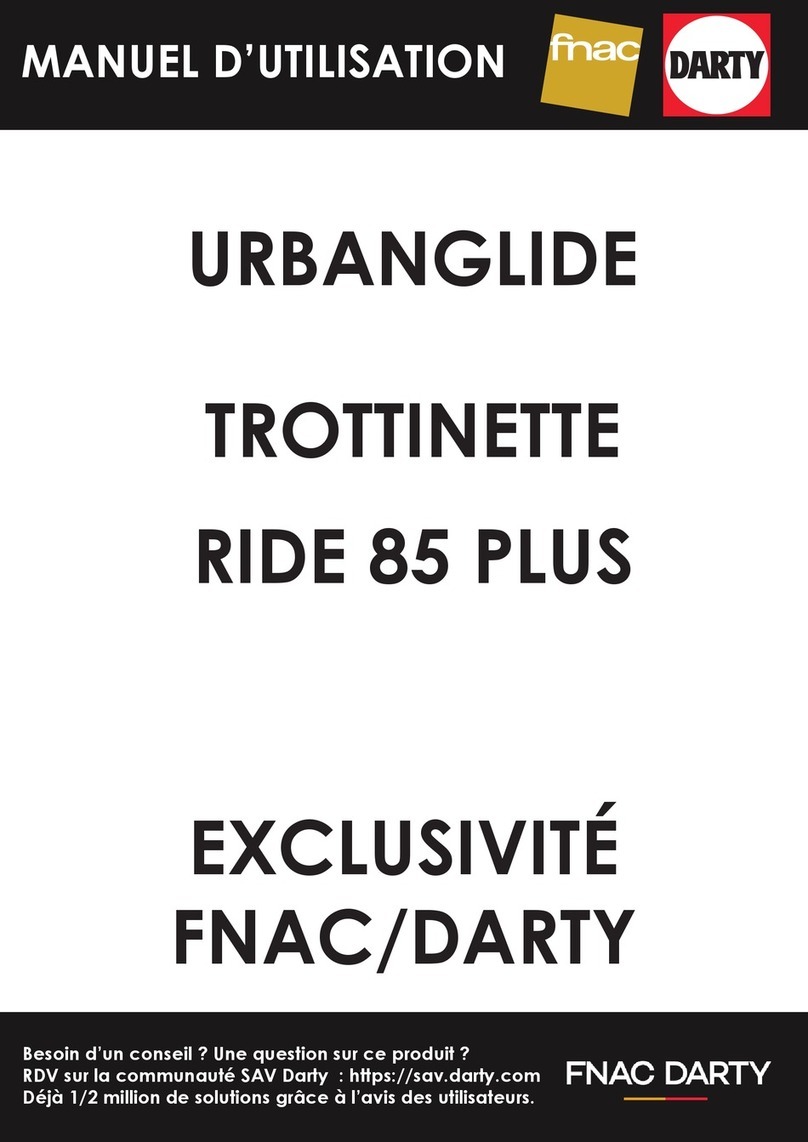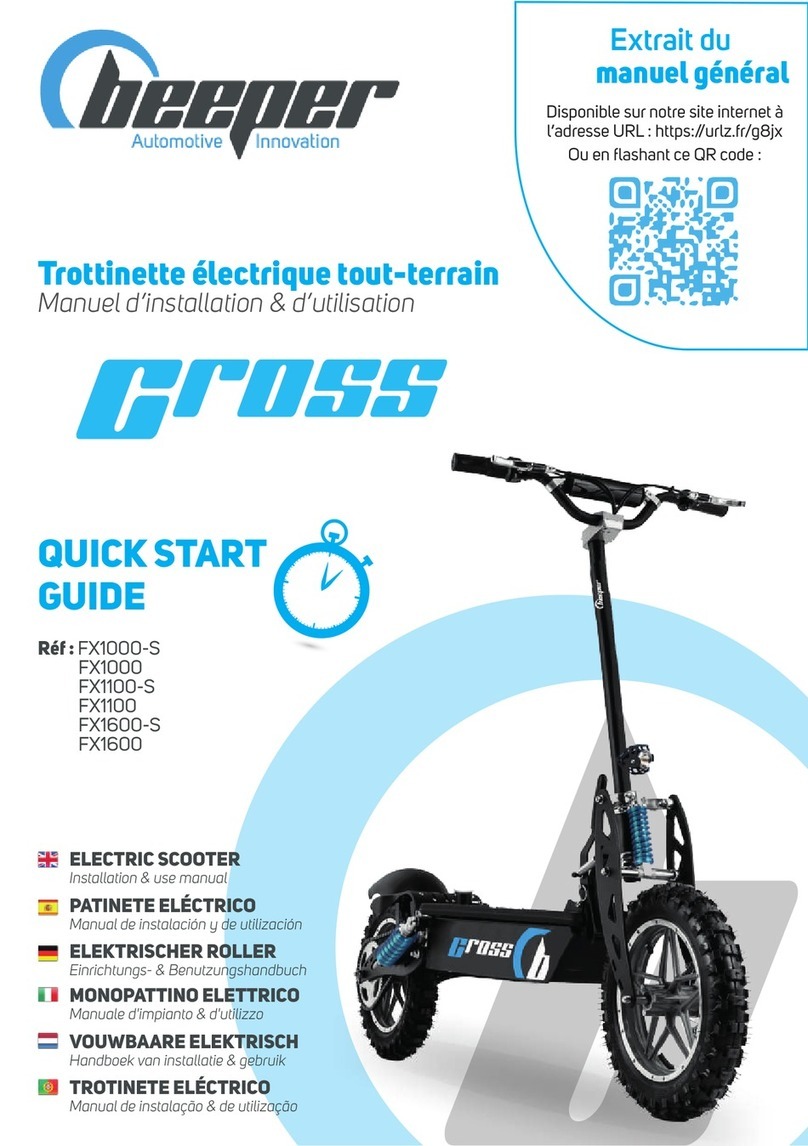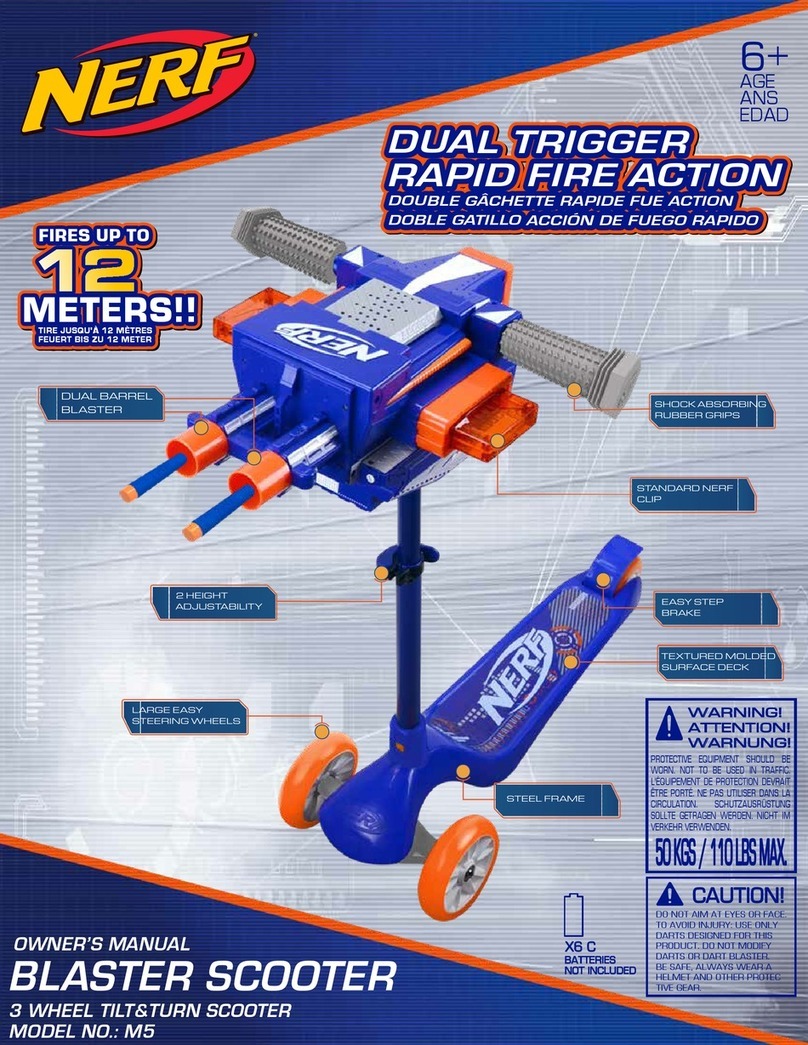Hercules Rob Family F360 Quick guide

TRANSLATION OF THE ORIGINAL
OPERATING INSTRUCTIONS
IMPORTANT
READ CAREFULLY BEFORE USE
KEEP SAFE TO CONSULT AT A LATER DATE
Pedelecs with Intuvia display
Rob Family F360
21-P-0001 - 21-P-0014 | 21-Q-0001 - 21-Q-0015 | 21-Q-0034 - 21-Q-0042 | 21-Q-0048, 21-Q-0049 | 21-Q-0066 - 21-Q-0069
21-Q-0081, 21-Q-0082 | 21-X-0001, 21-X-0002 | 21-Y-0002 - 21-Y-0011
MY21H01 - 32• 1.0 • 30. July 2020
TURBO
SPORT
TOUR
ECO
OFF
MPH
KM/H
Reichweite
AMM
PMWH
MIN
MPH
KM /H
RESET
TURBO
SPOR T
S
TOUR
ECO
OFF
MPH
KM/H
Reichweite
AMM
P MWH
MIN
MPH
KM
/H

MY21H01 - 32_1.0_30.07.2020 2
Contents
Contents
1 About these operating instructions 6
1.1 Manufacturer 6
1.2 Language 6
1.3 Laws, standards and directives 6
1.4 For your information 6
1.4.1 Warnings 6
1.4.2 Markups 7
1.5 Nameplate 8
1.6 Type number and model 9
1.7 Identifying the operating instructions 9
2 Safety 10
2.1 Residual risks 10
2.1.1 Risk of battery fire and explosion 10
2.1.2 Risk of fire and explosion due to short
circuit in the battery 10
2.1.3 Fire hazard caused by overheated
charger 10
2.1.4 Electric shock caused by electric drive
system 10
2.1.5 Risk of a fall due to incorrectly set quick
releases 11
2.1.6 Risk of fire and burns due to hot motor 11
2.1.7 Key breaking off 11
2.2 Toxic substances 11
2.2.1 Brake fluid 11
2.2.2 Suspension oil 11
2.2.3 Defective battery 11
2.3 Requirements for the rider 11
2.4 Vulnerable groups 11
2.5 Personal protective equipment 11
2.6 Safety markings and safety instructions 12
2.7 What to do in an emergency 12
2.7.1 Dangerous situation in road traffic 12
2.7.2 Leaked brake fluid 12
2.7.3 Battery vapours emitted 13
2.7.4 Battery fire 13
2.7.5 Leaked brake fluid 13
2.7.6 Oil and lubricant leaks from the fork 13
2.7.7 Oil and lubricant leaks from the rear
frame damper 13
3Overview 14
3.1 Description 15
3.1.1 RANGE 15
3.1.1.1 Valve 15
3.1.2 Rigid fork 15
3.1.3 Brake system 15
3.1.3.1 Disc brake 15
3.1.4 Drive system 16
3.1.5 Rechargeable battery 16
3.1.5.1 Frame battery 17
3.1.5.2 Pannier rack battery 18
3.1.5.3 Integrated battery 18
3.1.6 Display 19
3.1.7 Control panel 19
3.1.7.1 USB port 19
3.1.8 Riding light 19
3.1.9 Charger 19
3.2 Proper use 20
3.3 Improper use 21
3.4 Data privacy information 21
3.4.1 Maximum permitted total weight 21
3.5 Environmental requirements 22
3.6 Technical data 24
3.6.1 Pedelec 24
3.6.2 Emissions 24
3.6.3 Tightening torque 24
3.6.4 Bicycle lighting 24
3.6.5 Intuvia display 24
3.6.6 USB port 24
3.6.7 Performance Line motor 24
3.6.8 PowerPack 500 battery 24
3.7 Description of controls and screens 25
3.7.1 Handlebars 25
3.7.2 Rechargeable battery 25
3.7.3 Display 25
3.7.4 Control panel 25
3.7.5 On-screen indicators 26
3.7.5.1 Riding light indicator 26
3.7.5.2 Level of assistance indicator 26
3.7.5.3 Battery level indicator (display screen) 26
3.7.5.4 Indicator for motor power used 27
3.7.5.5 Gear recommendation indicator 27
3.7.5.6 Tachometer indicator 27
3.7.5.7 Function display 27
3.7.5.8 Journey information 27
3.7.5.9 Additional journey information 27
3.7.5.10 System settings and data 28
3.7.5.11 Additional system settings 28
3.7.6 System message 29
3.7.7 ABS indicator lamp 29
4 Transporting and storing 30
4.1 Physical transport characteristics 30
4.1.1 Designated handles/lifting points 30
4.2 Transporting 30
4.3 Storing 30
4.3.1 Break in operation 30
4.3.1.1 Preparing a break in operation 30
4.3.1.2 Taking out of operation 31
5 Assembly 32
5.1 Required tools 32

MY21H01 - 32_1.0_30.07.2020 3
Contents
5.2 Unpacking 32
5.2.1 Scope of delivery 32
5.3 Preparing the battery 32
5.3.1 Checking the battery 32
5.4 Commissioning 33
5.4.1 Checking the stem and handlebars 33
5.4.1.1 Checking the connections 33
5.4.1.2 Firm hold 33
5.4.1.3 Checking the headset backlash 33
5.5 Pedelec sale 33
6 Operation 34
6.1 Risks and hazards 34
6.1.1 Personal protective equipment 35
6.2 Tips for a greater range 35
6.3 Error message 36
6.3.1 Display 36
6.3.2 Rechargeable battery 38
6.4 Instruction and customer service 39
6.5 Adjusting the pedelec 39
6.5.1 Adjusting the saddle 39
6.5.1.1 Adjusting the saddle tilt 39
6.5.1.2 Determining the seat height 39
6.5.1.3 Adjusting the seat height with
quick release 40
6.5.1.4 Height-adjustable seat post 40
6.5.1.5 Adjusting the seat position 41
6.5.2 Adjusting the handlebars 41
6.5.3 Adjusting the stem 41
6.5.3.1 Adjusting the height of the handlebars 41
6.5.3.2 Adjusting the quick release
clamping force 42
6.5.4 Retracting the brake linings 42
6.6 Accessories 43
6.6.1 Child seat 43
6.6.2 Trailer 44
6.6.3 Pannier rack 44
6.7 Check list before each ride 45
6.8 Using the kickstand 46
6.8.1 Raising the kickstand 46
6.9 Using the pannier rack 46
6.10 Using the saddle 46
6.11 Rechargeable battery 47
6.11.1 Frame battery 47
6.11.1.1 Removing the frame battery 47
6.11.1.2 Inserting the frame battery 47
6.11.2 Pannier rack battery 47
6.11.2.1 Removing the pannier rack battery 47
6.11.2.2 Inserting the pannier rack battery 47
6.11.3 Integrated battery 48
6.11.3.1 Removing the integrated battery 48
6.11.3.2 Inserting the integrated battery 48
6.11.4 Charging the battery 49
6.11.5 Charging the dual battery 49
6.11.5.1 Charging process when two batteries
are used 49
6.11.5.2 Charging process when one battery
is used 50
6.11.6 Using double battery model with a
single battery only 50
6.11.7 Waking the battery 50
6.12 Electric drive system 51
6.12.1 Switching on the electric drive system 51
6.12.2 Switching off the drive system 51
6.13 Control panel with display 52
6.13.1 Removing and attaching the display 52
6.13.1.1 Removing the display 52
6.13.1.2 Attaching the display 52
6.13.2 Securing the display against removal 52
6.13.3 Charging the display battery 52
6.13.3.1 Charging on the pedelec 53
6.13.3.2 Charging using the USB port 53
6.13.4 Using the USB port 53
6.13.5 Switching on the display 53
6.13.6 Switching off the display 53
6.13.7 Using the push assist system 53
6.13.8 Using the riding light 53
6.13.9 Selecting the level of assistance 54
6.13.10 Journey information 54
6.13.10.1Switching the displayed journey
information 54
6.13.10.2Resetting the journey information 54
6.13.11 Changing the system settings 54
6.14 Brake 55
6.14.1 Using the brake lever 56
6.15 Gear shift 57
6.15.1 Using the derailleur gears 57
6.16 Parking the pedelec 58
7 Cleaning and servicing 59
7.1 Cleaning after each ride 59
7.1.1 Cleaning the suspension fork 59
7.1.2 Cleaning the pedals 59
7.2 Basic cleaning 60
7.2.1 Cleaning the frame 60
7.2.2 Cleaning the stem 60
7.2.3 Cleaning the wheel 60
7.2.4 Cleaning the drive elements 60
7.2.5 Cleaning the chain 61
7.2.6 Cleaning the battery 61
7.2.7 Cleaning the display 61
7.2.8 Cleaning the motor 61
7.2.9 Cleaning the brake 62
7.2.10 Cleaning the saddle 62
7.3 Servicing 62
7.3.1 Servicing the frame 62
7.3.2 Servicing the stem 62

MY21H01 - 32_1.0_30.07.2020 4
Contents
7.3.3 Servicing the fork 62
7.3.4 Servicing the drive elements 62
7.3.5 Servicing the pedals 62
7.3.6 Servicing the chain 62
7.4 Maintenance 63
7.4.1 Wheel 63
7.4.1.1 Checking the tyres 63
7.4.1.2 Checking the rims 63
7.4.1.3 Checking and adjusting the tyre
pressure – Dunlop valve 63
7.4.1.4 Checking and adjusting the tyre
pressure – Presta valve 64
7.4.1.5 Checking and adjusting the tyre
pressure – Schrader valve 64
7.4.2 Brake system 64
7.4.3 Checking the brake linings for wear 64
7.4.4 Checking the pressure point 65
7.4.5 Checking the brake discs for wear 65
7.4.6 Checking the electrical cables and
brake cables 65
7.4.7 Checking the gear shift 65
7.4.8 Checking the stem 65
7.4.9 Checking the USB port 65
7.4.10 Checking the chain tension 65
8 Maintenance 66
8.1 Suspension system 67
8.1.1 Rear frame damper 67
8.1.2 Suspension fork 68
8.1.3 Suspension seat post 69
8.2 Axle with quick release 69
8.2.1 Checking the quick release 70
8.3 Maintaining the stem 70
8.4 Adjusting the gear shift 70
8.4.1 Cable-operated gear shift,
single-cable 71
8.4.2 Cable-operated gear shift,
dual-cable 71
8.4.3 Cable-operated twist grip,
dual-cable 71
9 Troubleshooting, fault clearance
and repair 72
9.1 Troubleshooting and fault clearance 72
9.1.1 The drive system or display do not
start up 72
9.1.2 Error message 72
9.1.3 Assistance function errors 73
9.1.4 Battery error 74
9.1.5 Display errors 75
9.1.6 Lighting does not work 75
9.1.7 Other errors 76
9.2 Repair 76
9.2.1 Original parts and lubricants 76
9.2.2 Replacing the lighting 76
9.2.3 Adjusting the headlight 76
9.2.4 Tyre clearance check 76
10 Recycling and disposal 77
11 Documents 78
11.1 Parts list 78
11.1.1 Rob Family F360 78
11.2 Assembly report 79
11.3 Maintenance instructions 81
11.4 Charger operating instructions 85
12 Glossary 93
12.1 Abbreviations 95
12.2 Simplified terms 95
13 Appendix 96
I. Translation of the original EC/EU
Declaration of Conformity 96
II Declaration of conformity for
incomplete machine 97
14 Keyword index 100

MY21H01 - 32_1.0_30.07.2020 5
About these operating instructions
Thank you for your trust!
HERCULES pedelecs are premium quality
bicycles. You have made an excellent choice.
Your specialist dealer will provide you with
guidance and instruction and assemble your
product. Your specialist dealer will also be happy
to assist you in the future whether you require
maintenance, conversion or repair.
You are receiving these operating instructions
with your new pedelec. Please take time to
become familiar with your new pedelec and follow
the tips and suggestions in the operating
instructions. They will help you to enjoy your
pedelec for a long time to come. We hope you
have fun and wish you well on all of your rides!
These operating instructions are mainly designed
for the rider or the operator. They aim to ensure
that non-professionals can use the pedelec safely.
Download the operating
instructions onto your
phone at the following link,
so that you can use them
when you are out riding:
https://www.hercules-bikes.de/de/de/index/
downloads.html.
Copyright
© HERCULES GmbH
Distribution or reproduction of these operating
instructions and utilisation or communication of
their content is prohibited unless expressly
approved. Any infringement will render the
offender liable for compensation. All rights
reserved in the event that a patent, utility model or
industrial design is registered.
Editing
Text and images:
HERCULES GmbH
Longericher Strasse 2
50739 Köln, Germany
Translation:
RKT Übersetzungs- und Dokumentations-GmbH
Markenstrasse 7
40227 Düsseldorf, Germany
Notice
These operating instructions are not a substitute
for personal instruction by the supplying specialist
dealer.
These operating instructions are an integral part
of the pedelec. Therefore, if it is re-sold at a later
time, they must be handed over to the subsequent
owner.
Sections are also designed especially for the
specialist dealer. These sections aim to ensure
that specialist dealers complete initial assembly
and maintenance safely and reliably. The
sections for specialist dealers are highlighted in
grey and marked with a spanner symbol.

MY21H01 - 32_1.0_30.07.2020 6
About these operating instructions
1 About these operating
instructions
1.1 Manufacturer
The pedelec manufacturer is:
HERCULES GmbH
Longericher Strasse 2
50739 Köln, Germany
Tel.: +49 4471 18735 0
Fax: +49 4471 18735 29
E-mail: [email protected]
Internet: www.hercules-bikes.de
Subject to internal changes
The information contained in these operating
instructions are the approved technical
specifications at the time of printing. Any
significant changes are included in a new
published version of the operating instructions.
You will find any modifications to these operating
instructions at:
https://www.hercules-bikes.de/de/de/index/
downloads.htm
1.2 Language
The original operating instructions are written in
German. A translation is invalid without the
original operating instructions.
1.3 Laws, standards and directives
The operating instructions comply with the
essential requirements specified in:
• Machinery Directive 2006/42/EC
• Electromagnetic Compatibility Directive
2014/30/EU
• ISO 20607:2018 Safety of machinery –
Instruction handbook – General drafting
principles
• EN 15194:2018 Cycles – Electrically power
assisted cycles – pedelec bicycles
• EN 11243:2016, Cycles – Luggage carriers for
bicycles – Requirements and test methods
• ISO 17100:2016-05 Translation Services –
Requirements for translation services.
1.4 For your information
Different markings are used in the operating
instructions to make them easier to read.
1.4.1 Warnings
Warnings indicate hazardous situations and
actions. You will find warnings in the operating
instructions:
Will lead to serious or even fatal injuries if
ignored. High-risk hazard.
May lead to serious or even fatal injuries if
ignored. Medium-risk hazard.
May lead to minor or moderate injuries if ignored.
Low-risk hazard.
Notice
May lead to material damage if ignored.
DANGER
!
WARNING
!
CAUTION
!

MY21H01 - 32_1.0_30.07.2020 7
About these operating instructions
1.4.2 Markups
You will find stylised forms of typeface in the
operating instructions:
Instructions for specialist dealers are highlighted
in grey. They are indicated by a screwdriver
symbol. Information for specialist dealers does
not require non-professionals to take any action.
Stylised form Use
Italics Glossary term
Underlined in blue Link
Underlined in grey Cross references
Check marks Requirements
Triangle Instruction for action
1Instruction for
action
Several instructions for
action in specified order
Result of the action
SPACED Indicators on the display
screen
• Bulleted lists
Only applies to
pedelecs with this
equipment
Each type has a different
kind of equipment. A
note beneath the
heading indicates
components which can
be used as an
alternative.
Table 1: Markups

MY21H01 - 32_1.0_30.07.2020 8
About these operating instructions
1.5 Nameplate
The nameplate is situated on the frame. You can
see the exact position of the nameplate in Figure 2.
You will find thirteen pieces of information on the
nameplate.
Figure 1: Example Nameplate
No. Designation Description
1CEmarking The manufacturer uses the CE marking to declare that the pedelec complies with
applicable requirements.
2 Manufacturer's contact details You can contact the manufacturer at the address. You can find more information in
Section 1.
3 Type number All pedelec models have an eight-digit type number, which is used to specify the design
model year, the type of pedelec and the version. You can find more information in
Section 1.
4 Maximum continuous power The maximum continuous power is the greatest possible power for the electric motor
output shaft over 30 minutes.
5 Maximum permitted total weight The maximum permitted total weight is the weight of the fully assembled pedelec with the
rider and baggage.
6 Year of manufacture The year of manufacture is the year in which the pedelec was manufactured. The
production period is from August 2019 to July 2020.
7 Pedelec type You can find more information in Section 3.2.
8 Safety markings You can find more information in Section 1.4.
9 Disposal instructions You can find more information in Section 10.
10 Area of use You can find more information in Section 3.5.
11 Model year The model year refers to the first production year that the series-manufactured pedelec
was produced in the version concerned. The year of manufacture is different to the model
year in some cases.
12 Weight of the ready-to-ride pedelec The weight of the ready-to-ride pedelec is specified as a weight of 25 kg or above and
refers to its weight at the time of purchase. You must add each additional accessory to
the weight.
13 Shut-off speed The speed that the pedelec reaches at the moment when the current has dropped to zero
or to the no-load current value.
Table 2: Nameplate details
Typ:
21-17-1017
0,25 kW / 25 km/h
zGG 150 kg
EPAC 25 kg
BJ 2020 / MJ 2021
EN 15194
nach
EPAC
2
3
1
4
5
6
7
89
12
13
10
11
Hercules GmbH
Longericher Str. 2
50739 Köln, Germany

MY21H01 - 32_1.0_30.07.2020 9
About these operating instructions
1.6 Type number and model
These operating instructions are an integral part
of pedelecs with the type numbers:
1.7 Identifying the operating
instructions
The Identification number position is located on
bottom left-hand side on each page. The
identification number is composed of the
document number, the version number and the
release date.
Type no. Model Pedelec type
21-X-0002 Rob Family F360 City and trekking
bicycle
Table 3: Type number, model and pedelec type
Identification number MY21H01 - 32_1.0_30.07.2020

MY21H01 - 32_1.0_30.07.2020 10
Safety
2 Safety
2.1 Residual risks
2.1.1 Risk of battery fire and explosion
The safety electronics may fail if the batteries are
damaged or faulty. The residual voltage can
cause a short circuit. The battery may self-ignite
and explode.
Only use and charge the battery and
accessories if they are in perfect condition.
Never open or repair the battery.
Batteries with external damage must be
removed from service immediately.
If a battery is dropped or struck, remove it from
service and observe it for at least 24 hours.
Faulty batteries are hazardous goods. Dispose
of faulty batteries in the correct manner. Store
battery in a dry place until disposal. Never
store in the vicinity of flammable substances.
The battery is only protected from spray water.
Penetration by water can cause a short circuit.
The battery may self-ignite and explode.
Never immerse the battery in water.
Put battery out of service if you suspect water
has penetrated it.
Temperatures over 60 °C can also cause liquid to
leak from the battery and the battery will become
damaged. The battery may self-ignite and
explode.
Protect the battery against heat.
Never store next to hot objects.
Never expose the battery to sustained direct
sunlight.
Avoid wide temperature fluctuations.
2.1.2 Risk of fire and explosion due to
short circuit in the battery
Metal objects may connect the battery's electrical
terminals. The battery may self-ignite and
explode.
Never insert paper clips, screws, coins, keys
and other small parts into the battery.
Chargers with excessive voltage damage
batteries. This may result in fire or an explosion.
Only use batteries approved for the pedelec.
Clearly label the supplied charger.
2.1.3 Fire hazard caused by overheated
charger
The charger heats up when charging the battery.
In case of insufficient cooling, this can result in fire
or burns to the hands.
Never use charger on a highly flammable
surface.
Never cover the charger during charging.
Never leave the battery unattended during
charging.
2.1.4 Electric shock caused by electric
drive system
Damaged chargers, cables and plug connectors
increase the risk of electric shock.
Check the charger, cable and plug connector
before each use. Never use a damaged
charger.
If water penetrates into the charger, there is a risk
of electric shock.
Never charge the battery outdoors.

MY21H01 - 32_1.0_30.07.2020 11
Safety
2.1.5 Risk of a fall due to incorrectly set
quick releases
Excessively high clamping force will damage the
quick release and cause it to lose its function.
Insufficient clamping force will result in
unfavourable transmission of force. This can
cause components to break. This will cause a
crash with injuries.
Never fasten a quick release using a tool (e.g.
hammer or pliers).
Only use the clamping lever with the specified
set clamping force.
2.1.6 Risk of fire and burns due to hot
motor
The motor housing becomes hot when riding.
Touching it may cause burns to the skin or other
objects.
Never touch the motor housing directly after
riding.
Never place the pedelec on a flammable
surface, such as grass or wood, directly after
use.
2.1.7 Key breaking off
If you leave a key inserted when riding or
transporting the pedelec, it may break off or the
locking system may open accidentally.
Remove the key to the battery lock.
2.2 Toxic substances
2.2.1 Brake fluid
Brake fluid may leak out after an accident or due
to material fatigue. Brake fluid can be fatal if
swallowed or inhaled.
Never dismantle the brake system.
Avoid contact with skin.
Do not inhale vapours.
2.2.2 Suspension oil
Suspension oil in the fork and the rear frame
damper is toxic to the touch, irritates respiratory
tracts and causes cancer, sterility and mutation in
germ cells.
Never dismantle the rear frame damper or the
suspension fork.
Avoid contact with skin.
2.2.3 Defective battery
Liquids and vapours may leak from damaged or
faulty batteries. Excessively high temperatures
may also cause liquids and vapours to leak from
the battery. Such liquids and vapours can irritate
the airways and cause burns.
Never dismantle the battery.
Avoid contact with skin.
Do not inhale vapours.
2.3 Requirements for the rider
The rider must demonstrate adequate physical,
motor and mental abilities to ride on public roads.
A minimum age of 14 years is recommended.
2.4 Vulnerable groups
Keep batteries and charger away from children
and people with reduced physical, sensory or
mental capabilities or lacking in experience and
knowledge.
If minors use the pedelec, a legal guardian must
should provide them with comprehensive
instructions.
2.5 Personal protective equipment
Wear a suitable cycling helmet, sturdy footwear
and typical close-fitting clothing to provide
protection.

MY21H01 - 32_1.0_30.07.2020 12
Safety
2.6 Safety markings and safety
instructions
The nameplate contains these safety markings
and safety instructions:
2.7 What to do in an emergency
2.7.1 Dangerous situation in road traffic
In the event of any hazards or dangers in road
traffic, apply the brakes on the pedelec until it
comes to a halt. The brake acts as an
emergency stop system in such cases.
2.7.2 Leaked brake fluid
Remove those affected from the danger area to
fresh air.
Never leave those affected unattended.
Immediately remove any clothing items
contaminated with brake fluid.
Never inhale vapours. Ensure sufficient
ventilation.
Wear gloves and safety gloves as protective
equipment.
Keep unprotected persons away.
Take care with leaked brake fluid as it poses a
slip hazard.
Keep leaked brake fluid away from naked
flames, hot surfaces and sources of ignition.
Avoid contact with skin and eyes.
After inhalation
Take in fresh air. Immediately consult a doctor
in case of any discomfort.
After skin contact
Wash affected skin with soap and water and
rinse well. Remove contaminated clothing.
Consult doctor in the event of pain or
discomfort.
After contact with eyes
Rinse eyes under flowing water for at least ten
minutes with the lids open; also rinse under
lids. Immediately consult a doctor in case of
any pain or discomfort.
Symbol Explanation
General warning
Adhere to the instructions for use
Table 4: Meaning of safety markings
Symbol Explanation
Read the instructions
Separate collection of electrical
and electronic devices
Separate collection of ordinary
and rechargeable batteries
Must not be thrown into fire
(burning prohibited)
It is forbidden to open any
batteries
Device of protection class II
Only suitable for use indoors
Fuse (device fuse)
EU conformity
Recyclable material
Protect from temperatures
above 50 °C and direct sunlight
Table 5: Safety instructions
max. 50°C

MY21H01 - 32_1.0_30.07.2020 13
Safety
After swallowing
Rinse out mouth with water. Never induce
vomiting. Risk of aspiration!
If a person is lying on their back and vomiting,
place them in the recovery position. Seek
medical advice immediately.
Environmental protection measures
Never allow brake fluid to flow into the sewage
system, water courses or groundwater.
Notify the relevant authorities if fluid
penetrates the ground, water courses or the
sewage system.
Consult a doctor immediately in the event of
any pain or discomfort caused by combustion
gas or leaking fluids.
2.7.3 Battery vapours emitted
Vapours may be emitted if the battery is damaged
or used improperly. The vapours may cause
respiratory tract irritation.
Get into fresh air.
Consult doctor in the event of pain or
discomfort.
After contact with eyes
Carefully rinse eyes with plenty of water for at
least 15 minutes. Protect unaffected eye. Seek
medical advice immediately.
After skin contact
Remove any solid particles immediately.
Rinse the affected area with plenty of water for
at least 15 minutes. Then dab the affected skin
gently. Do not rub dry.
Remove contaminated clothing immediately.
Immediately consult a doctor if there is any
redness, pain or discomfort.
2.7.4 Battery fire
The safety electronics may fail if the battery is
damaged or faulty. The residual voltage can
cause a short circuit. The battery may self-ignite
and explode.
1Keep your distance if the battery becomes
deformed or starts to emit smoke.
2If charging, remove the plug connector from
the socket.
3Contact the fire service immediately.
Use Class fire extinguishers to put out the fire.
Never extinguish damaged batteries with water
or allow them to come into contact with water.
Inhaling vapours can cause intoxication.
Stand on the side of the fire where the wind is
blowing from.
Use breathing apparatus if possible.
2.7.5 Leaked brake fluid
The brake system must be repaired immediately if
brake fluid leaks out. Dispose of leaking brake
fluid in an environmentally responsible way in
accordance with statutory regulations.
Contact your specialist dealer.
2.7.6 Oil and lubricant leaks from the fork
Dispose of oils and lubricants which have leaked
from the rear frame damper in an environmentally
responsible way in compliance with statutory
regulations.
Contact your specialist dealer.
2.7.7 Oil and lubricant leaks from the rear
frame damper
Dispose of oils and lubricants which have leaked
from the rear frame damper in an environmentally
responsible way in accordance with statutory
regulations.
Contact your specialist dealer.

MY21H01 - 32_1.0_30.07.2020 14
Overview
3Overview
Figure 2: Pedelec viewed from the right, HERCULES Rob Family F360
1Front wheel
2Fork
3 Front guard
4 Headlight
5Handlebars
6Stem
7Frame
8 Seat post
9 Saddle
10 Nameplate
11 Pannier rack
12 Rear guard
13 Rear light
14 Rear wheel
15 Chain
16 Batteries
17 Motor
18 Chain guard
19 Motor
20 Pedal
1
2
3
4
5
678910111213
14
15 16 1718 19 20

MY21H01 - 32_1.0_30.07.2020 15
Overview
3.1 Description
3.1.1 RANGE
Figure 3: Visible wheel components
1Tyres
2 Rim
3 Spoke
4 Spoke nipples
5Hub
6Valve
The wheel comprises the wheel itself, a hose with
a valve and a tyre.
3.1.1.1 Valve
Each wheel has a valve. It is used to fill the tyre
with air. There is a valve cap on each valve. The
screw-on valve cap keeps out dust and dirt.
The pedelec has either
• a classic Dunlop valve,
• a French valve (also known as a Sclaverand or
Presta valve) or
• a Schrader valve.
3.1.2 Rigid fork
Rigid forks do not feature suspension. They transfer
the used muscle and motor power to the road to
optimum effect. Pedelecs with rigid forks consume
less energy on steep roads and have a greater range
than pedelecs with adjusted suspension.
3.1.3 Brake system
Every pedelec has a hydraulic brake system. The
brake fluid is in a closed hose system. If the rider
pushes the brake lever, the brake fluid activates
the brake on the wheel.
The mechanical brakes are used as an
emergency stop system and bring the bicycle to a
halt quickly and safely in the event of an
emergency.
3.1.3.1 Disc brake
Figure 4: Brake system with disc brake – example
1Brakedisc
2 Brake calliper with brake linings
3Handlebars with brake lever
4 Front wheel brake disc
5 Rear wheel brake disc
On a pedelec with a disc brake, the brake disc is
screwed permanently to the wheel hub. The brake
lever is pushed to increase brake pressure. The
brake fluid is used to transfer pressure through
the brake cables to the cylinders in the brake
calliper. The braking force is boosted by a speed
reduction and applied to the brake linings. These
apply the brake disc mechanically. If the brake
lever is pushed, the brake linings are pressed
against the brake disc and the wheel movement is
decelerated until it comes to a stop.
1
2
3
6
5
4
1
2
3
4
5

MY21H01 - 32_1.0_30.07.2020 16
Overview
3.1.4 Drive system
The pedelec is driven by muscle power applied to
the chain drive. The force which is applied by
pedalling in the direction of travel drives the front
chain wheel. The chain transmits the force onto
the rear chain wheel and then onto the rear wheel.
Figure 5: Diagram of mechanical drive system
1 Direction of travel
2 Chain
3 Rear chain wheel
4 Front chain wheel
5 Pedal
The pedelec also has an integrated electric drive
system in addition to its mechanical drive system.
As soon as the required muscle power from the
rider pedalling passes a certain level, the motor is
activated gently and assists the rider’s pedalling
motion. The pre-set level of assistance
determines the motor output.
The pedelec does not have a separate emergency
shut-off button. The electric drive system can be
stopped by removing the display in the event of an
emergency. The mechanical brakes are used as
an emergency stop system and bring the bicycle
to a halt quickly and safely in the event of an
emergency.
The motor switches off automatically as soon as
the rider no longer pedals, the temperature is
outside the permitted range, there is an overload
or the shut-off speed of 25 km/h has been
reached.
The electric drive system is made up of
8 components:
Figure 6: Diagram of electric drive system
1 Headlight
2 Display, more in Section 3.1.6
3 Control panel, more in Section 3.1.7
4.1 Integrated battery, more in Section 3.1.5.3
4.2 Frame battery, more in Section 3.1.5.1
4.3 Pannier rack battery, more in Section 3.1.5.2
5 Rear light
6 Electric gear shift (alternative)
7Motor
• A charger designed for the battery.
A push assist system can be activated. The speed
depends on the selected gear. The push assist
continues to drive the pedelec as long as the rider
presses the push assist button on the handlebars.
The speed can be a maximum of 6 km/h in this
case. The electric drive system stops when the
push assist button is released.
3.1.5 Rechargeable battery
Bosch batteries are lithium ion batteries which are
developed and manufactured to the latest
technical standards. Each individual cell is
protected by a steel cup and encased in a plastic
battery housing. These batteries meet and exceed
applicable industrial safety standards. The battery
has an internal electronic protection circuit, which
is specifically designed for the charger and the
pedelec. The battery temperature is monitored at
all times. The battery is protected against deep
discharge, overcharging, overheating and short
circuit. In the event of a hazard, a protective circuit
switches the battery off automatically.
5
2
4
1
B
3
1
2
4.2
4.1
4.3
5
6
7

MY21H01 - 32_1.0_30.07.2020 17
Overview
The battery has a high energy content when
charged. You will find codes of practice for their
safe handling in Section 2 Safety and Section 6.9
Rechargeable battery in the operating
instructions.
If the electric drive system is not used for about
10 minutes and no button has been pressed on
the display or the control panel, the electric drive
system and the battery are automatically switched
off to save energy.
The type and duration of operating conditions
have a significant effect on the battery life. Just
like any other lithium-ion battery, the battery will
age naturally if it is not being used. The battery's
service life can be extended if the battery is well
maintained and stored at the correct temperature.
The charging capacity will decrease with age,
even if the battery is maintained properly. If the
operating time is severely shortened after
charging, this is a sign that battery has reached
the end of its useful life.
Battery performance is reduced when the
temperature drops since this increases electrical
resistance. As a result, you can expect the range
to be shorter than normal in winter. We
recommend using thermal protection sleeves
when riding longer distances in the cold.
The pedelec features either an integrated battery,
a pannier rack battery or a frame battery. Each
battery has its own lock.
3.1.5.1 Frame battery
Three different types of frame batteries can be
fitted:
Figure 7: Details of frame battery
1 Battery housing
2 Battery lock
3 Battery key
4 On-Off button (battery)
5 Battery level indicator (battery)
6 Charging port cover
7 Charging port
PowerPack 300 PowerPack 400 PowerPack 500
Table 6: Overview of frame batteries
1
2
3
4
5
678

MY21H01 - 32_1.0_30.07.2020 18
Overview
3.1.5.2 Pannier rack battery
Three different types of pannier rack batteries can
be fitted:
Figure 8: Overview of pannier rack battery
Figure 9: Details of pannier rack battery
1 Battery housing
2 Charging port
3 Charging port cover
4Batterylock
5Batterykey
6 Battery level indicator (battery)
7 On-Off button (battery)
3.1.5.3 Integrated battery
Three different types of integrated batteries can
be fitted:
Figure 10: Overview of frame batteries
Figure 11: Integrated battery in detail
1 Battery key
2 Retainer guard
3 Securing hook
4 On-Off button (battery)
5 Battery level indicator (battery)
6 Battery housing
PowerPack 300 PowerPack 400 PowerPack 500
1
2
3
4
5
6
78
PowerTube 400 PowerTube 500 PowerTube 625
(vertical and horizontal)
1
2
3
4
5
2
6

MY21H01 - 32_1.0_30.07.2020 19
Overview
3.1.6 Display
The model series to which these instructions
apply features the BOSCH Intuvia display. In
addition to the functions described here, software
changes may be introduced to rectify errors and
extend functions at any time. The display controls
the electric drive system with four operating
elements and shows the journey data. The rider
can switch off the electric drive system by
removing the display. The battery powers the
display if the display is inserted in the mount, a
sufficiently charged battery is inserted into the
pedelec and the electric drive system is switched
on.
If the rider removes the display from its mount, the
display is powered by a display battery. The
display battery cannot be replaced.
Figure 12: BOSCH Intuvia display
3.1.7 Control panel
The control panel controls the electric drive
system.
Figure 13: Control panel overview
3.1.7.1 USB port
There is a USB port beneath the rubber cover on
the right-hand edge of the display.
3.1.8 Riding light
When the riding light is activated, the headlight
and the rear light are switched on together.
3.1.9 Charger
Each pedelec is supplied with a charger. As a
general rule, any BOSCH charger may be used:
• The 2 A compact charger
• The 4 A standard charger
• The 6 A fast charger
Observe the operating instructions in the
Section 11 Documents.
TURBO
SPORT
TOUR
ECO
OFF
MPH
KM/H
Reichweite
AMM
PMWH
MIN
MPH
KM /H
RESET
TURBO
SPOR T
S
TOUR
ECO
OFF
MPH
KM/H
Reichweite
AMM
P MWH
MIN
MPH
KM
/H

MY21H01 - 32_1.0_30.07.2020 20
Overview
3.2 Proper use
The pedelec must only be used in perfect, fully
functional condition. National requirements may
apply to the pedelec which the standard
equipment may not meet. For riding on public
roads, some special regulations apply in relation
to the riding light, reflectors and other components.
The general laws and the regulations for the
prevention of accidents and environmental
protection in the respective country of use must be
adhered to. All check lists and instructions for
actions in these operating instructions met.
Approved accessories can be installed by
specialist staff.
The rechargeable batteries are designed to
supply power to the pedelec motor only and must
not be used for other purposes.
Each pedelec is assigned a pedelec type, which
determines its proper use, function and area of
use.
City and trekking
bicycles
Child's bicycles/
bicycles for young
adults
Mountain bikes Racing bicycle Cargo bike Folding bicycle
City and trekking
bicycles are designed
for daily, comfortable
use. They are
suitable for riding on
public roads.
The legal guardians
of minor riders must
read and understand
these operating
instructions before
commissioning.
The contents of these
operating
instructions must be
communicated to the
riders in an age-
appropriate manner.
The cycles for
children and young
adults are suitable for
riding on public
roads. The size of the
pedelec must be
checked regularly for
orthopaedic reasons.
A check must be
made at least every
three months to make
sure that the
maximum permitted
total weight is being
observed.
Mountain bikes are
designed for sporting
use. The design
characteristics
include a short
wheelbase, a sitting
position with the rider
inclined towards the
front, and a brake
requiring low
actuation force.
A mountain bike is a
piece of sporting
equipment. It requires
an adaptation period
and the rider must be
physically fit. Use
requires the
appropriate training;
in particular riding in
bends and braking
should be practised.
The strain on the
rider, in particular the
hands and wrists,
arms, shoulders,
neck and back, is
accordingly high.
Inexperienced riders
tend to brake
excessively and lose
control as a result.
A racing bicycle is
designed for fast
rides on roads and
paths with a good,
undamaged road
surface.
A racing bicycle is a
piece of sporting
equipment and not a
means of transport. A
racing bicycle is
characterised by its
lightweight structure
and a design which is
stripped to the
minimum parts
required for riding.
The frame geometry
and the layout of the
operating elements
are designed in such
a way that the bicycle
can be ridden at high
speeds. The frame
design requires
practice to ensure the
ride is able to ride
slowly, apply the
brakes and get on
and off the bike
safely.
The sitting position is
athletic. The strain on
the rider, in particular
the hands and wrists,
arms, shoulders,
neck and back, is
accordingly high. The
sitting position
therefore requires
physical fitness.
The cargo bike is
suitable for daily
transportation of
loads on public roads.
The transportation of
loads requires skill
and physical fitness
in order to balance
the additional weight.
The very varied
loading conditions
and weight
distributions require
special practice and
skill when braking
and riding in bends.
A longer period is
required to adaptation
to the length, width
and turning circle.
You need to be
cautious when riding
a cargo bike. You
must pay attention to
the traffic on public
roads and the
condition of the route
accordingly.
The folding bicycle is
suitable for use on
public roads.
A folding bicycle can
be folded up and is
thus suitable for
space-saving
transportation, for
example on public
transport or in a car.
The folding function
of the folding bicycle
makes it necessary to
use smaller wheels
and longer brake
cables and Bowden
cables. Therefore, in
case of an increased
load, a reduction in
riding stability and
braking power,
diminished comfort
and reduced
durability are to be
expected.
Table 7: Proper use for each pedelec type
Table of contents



